When at the market we discover a tiny spice shop.
The shelves are lined with huge jars of bright orange turmeric, cumin, garam masala, cinnamon and more. After making our selection to take home,
Peta is drawn to a large wooden sculpture of Buddha on one of the top shelves. She can’t stop looking at it. The vendor asks her if she wants it? “Yes”, she says, “I would love to have it, but I have no money.” Are you Buddhist, he asked her? “Yes” she answered him (it was easier to say yes, than to say, Jewish but with a strong affinity towards Buddhism.) At that response, the vendor beams with pleasure, and takes the sculpture down. He hands it to Peta and says “Here, this is for you. You pay me when you can pay me. That is fine.” And so, the Buddha, came home with us that day.
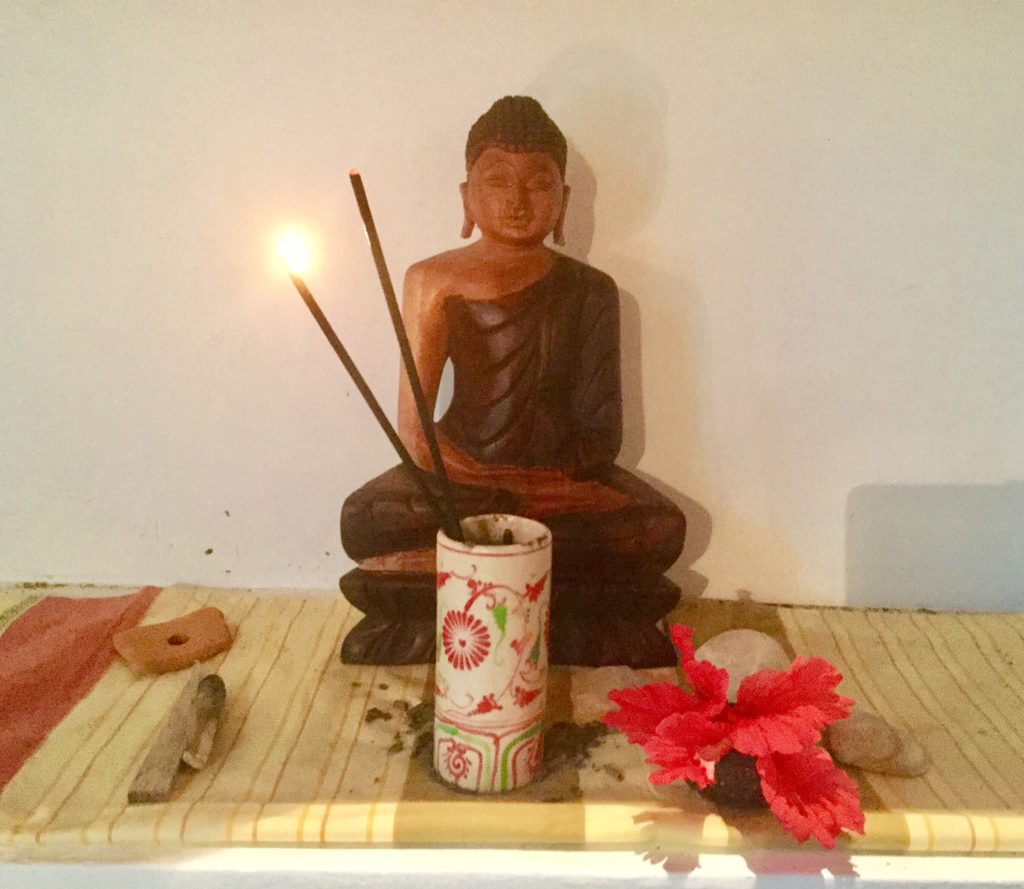 We live in a Buddhist country. Much of yoga’s underpinning philosophy correlates with Buddhist teachings. Peta has a (mostly) vegetarian diet, and will stop at nothing to try to protect an animal from abuse. She feels the energy of trees and she meditates. When flying and we encounter turbulence, she reaches for her Buddhist beads, (which she got from our monk teacher at a silent meditation retreat at a monastery in Northern Thailand.)
We live in a Buddhist country. Much of yoga’s underpinning philosophy correlates with Buddhist teachings. Peta has a (mostly) vegetarian diet, and will stop at nothing to try to protect an animal from abuse. She feels the energy of trees and she meditates. When flying and we encounter turbulence, she reaches for her Buddhist beads, (which she got from our monk teacher at a silent meditation retreat at a monastery in Northern Thailand.)
Does this make her a Buddhist? That could be a matter of debate, but it is clear that there is some significant convergence and Buddhism has been in our core trajectory for years now.
My (Ben) relationship with Buddhism is different. I was introduced to Theravada Buddhism in my first semester of school at UCLA, where a visiting Monk from Japan led an introduction to Buddhism course. Majoring in Asian studies, both as an under-grad and grad student, while my interest was in political science, Buddhism crept in, naturally.
In Tokyo, where I lived for several years, Buddhism, (Japan style) was all around. The one core tenet of Buddhism ~ namely re-incarnation ~ is one that I resonate with completely.
So with this as personal background, it is worth noting that as lay people, we observe Buddhism “from the periphery”. And the first thing that strikes, after 2+ years in Asia, is the interweaving of similarities and dissonance amongst the various Buddhist countries we have visited and lived in. We are conscious that we are just at the beginning of a life long learning curve.
In Thailand, the plethora of Buddhist temples, both in Bangkok and in Chiang Mai, made for an architecture ~ rich exposure to the magnificence of Buddhist temples. The opportunity to attend a meditation retreat led by a Buddhist monk was the highlight of our stay in Chiang Mai.

Wat Phra That Doi Suthep temple in Chiang Mai, Thailand.
In Luang Prabang, Laos, it was the mass of safran~robed monks all around us that formed our exposure to Buddhism. Peta went almost daily to hear the chanting at the Buddhist temple directly over the road from where we lived for a month. Rather than watching from afar, we had many opportunities for chats with our monk neighbors and had the satisfying experience of making friends with some of them.
The Luang Prabang community’s daily support of the monastic population, when hundreds of robed monks walk the early temple lined streets, receiving alms, highlighted the fact that Buddhism is part of every day life, and that the separation between monks and laymen is minimal.
Whereas the West used to have a near universal “military service” for young men, as they approached adulthood, Laos has a practice of universal monk-hood, where almost every boy enters the monastery and experiences life in a Buddhist monastery.

The hum of the daily chanting is meditative, calming and enticing. The temple across the road from our home in Luang Prabang.
In Indonesia, a mostly Muslim country, the island of Bali where we spent an extended period of time, is Buddhist. The temple rituals and prayers have little to do with what we observed in Thailand or Laos. Perhaps this is because of Bali’s unusual cultural history where both Hinduism and Buddhism converged. The Balinese prevalent belief is in “Agama Tirta” ~ Holy water religion ~ this practice is a Shivaite sect of Hinduism.
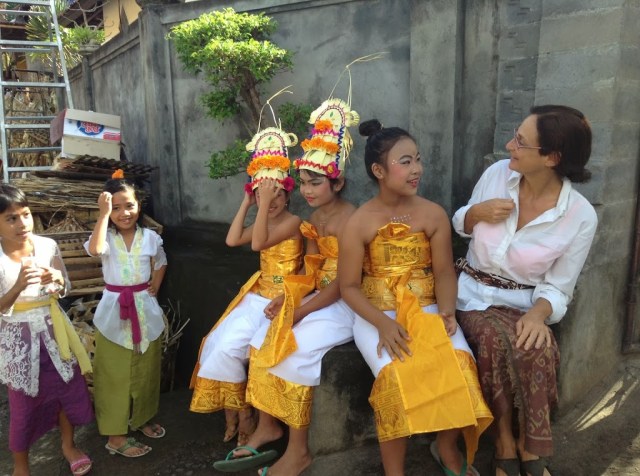
Being invited to a rare 100 year temple ceremony in rural Central Bali was an experience of a life time.
In Cambodia, 95% of the population practices Theravada Buddhist (same lineage as Thailand, Myanmar and Sri Lanka). Our exposure here to Buddhism was mostly limited to discovering the magnificence of Angkor Wat. Peta particularly enjoyed the opportunity to interact with elder female monks (known as nuns.)
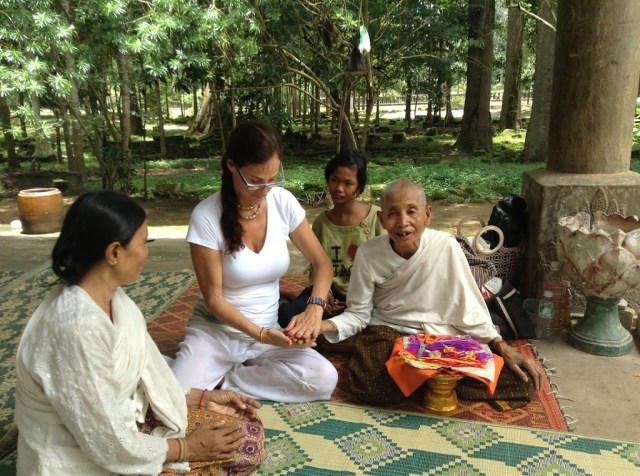
Peta receiving a red prayer bracelet from a nun in the grounds of Angkor Watt.
In Bagan Myanmar, it was about the architectural beauty of a valley dotted with hundreds of stupas and shrines and a rich trove of sculptures of Buddha.
Rather shockingly, in Myanmar, with its difficult colonial and post colonial history, and a decades long military Junta hold on the society, a Buddhist majority population has discarded its peaceful trappings to morph into an aggressive majority that routinely abuses its Muslim minority. Even the much admired Aung San Suu Kyi, former prisoner of the Junta, then Nobel prize winner, and finally de facto leader of the country’s government, cannot shake the blind animosity between the 89% Buddhist country and its Muslim minority. If one equates Buddhism with non-violence, then Myanmar may be the proverbial exception that proves the rule.
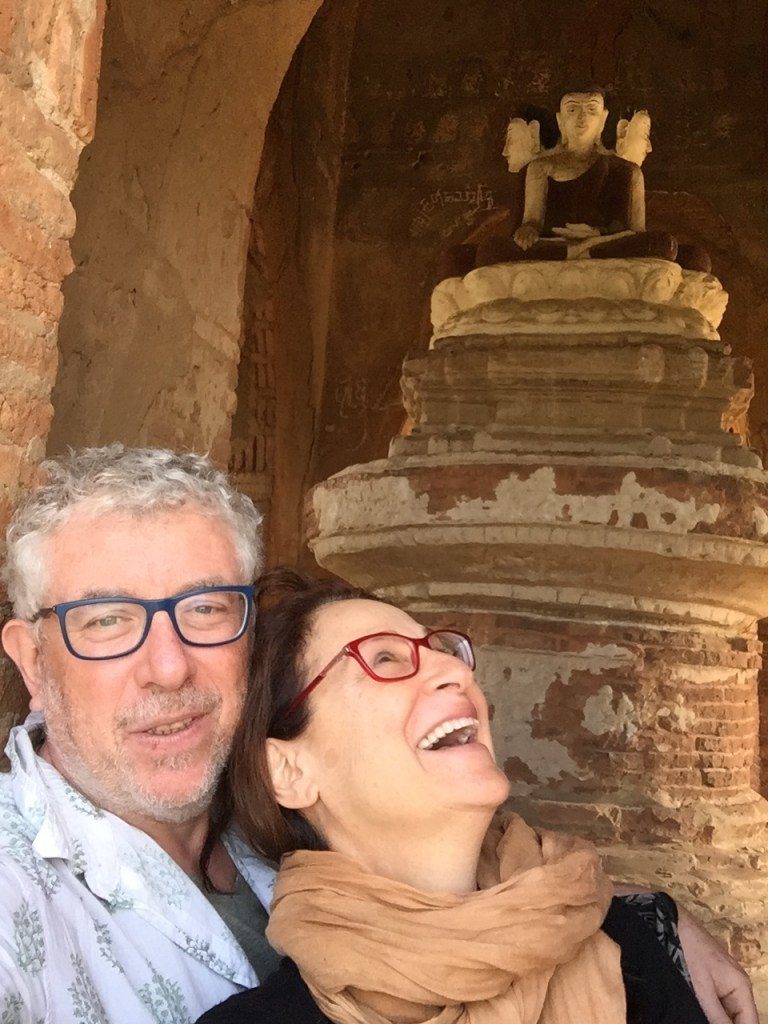
Temple in Bagan, Myanmar.
In Viet Nam, we encountered a different branch of Buddhism. Whereas Theravada Buddhism (with roots in India) is practiced in Thailand, Laos and Sri Lanka, ethnic Vietnamese practice mainly the Mahayana tradition. Buddhism may have first come to Viet Nam as early as the 3rd or 2nd century BCE from South Asia or from China in the 1st or 2nd century CE. Vietnamese Buddhism has had a symbiotic relationship with certain elements of Taoism, Chinese spirituality, and the Vietnamese folk religion.
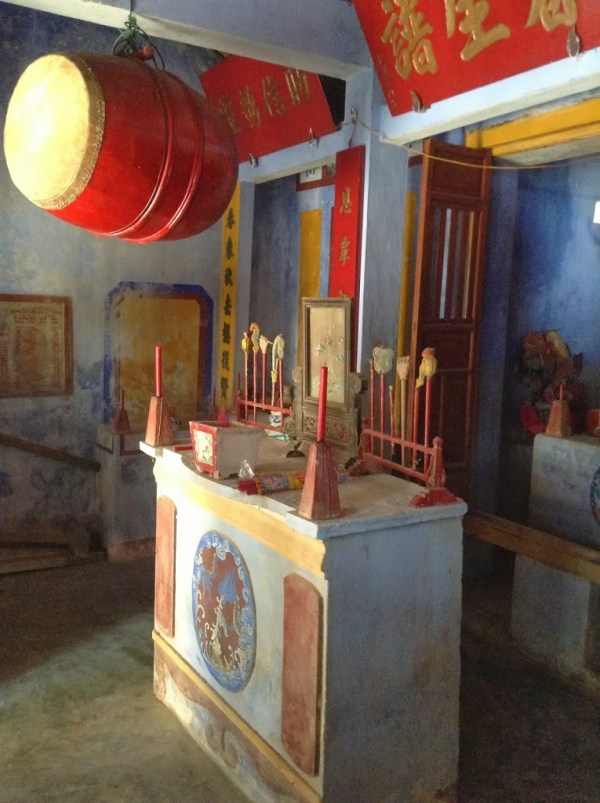
Small Buddhist temple on an island near Hoi An.
So now… back to our neighborhood, in Dalawella in Southern Sri Lanka.
Soon after moving into our new home, we hear that a nearby Buddhist temple (Yatagala Raja Maha Viharaya) holds a “Poya” ~ a full moon celebration. A Poya occurs every full moon and is important to Buddhists all around the world, who have adopted the lunar calendar for their religious observances. Owing to the moon’s fullness of size as well as its effulgence, the full moon day is treated as the most auspicious of the four lunar phases occurring once every lunar month and thus marked by a holiday.
We thus take the first full moon as an opportunity to join in the Buddhist celebration. After all, we have been exposed to and experienced a wide range of “same, same but different” variants of Buddhist practices and we are eager to ‘dip our toes’ into our local Buddhist community.
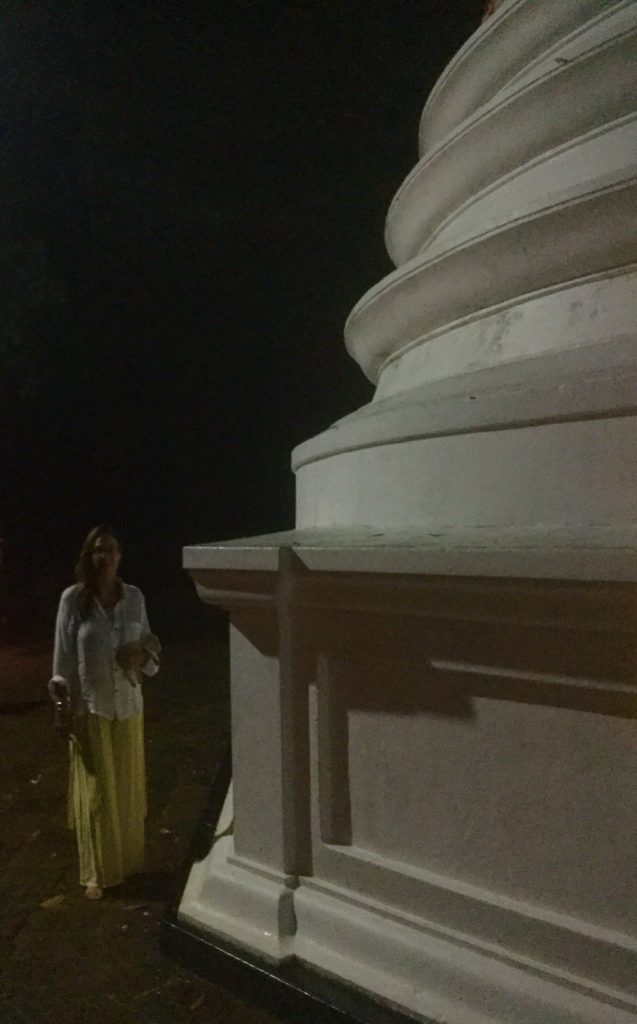
At our local temple in Dalawella, the large white stuppa at the temple, glows brightly in the moonlight against the night sky.
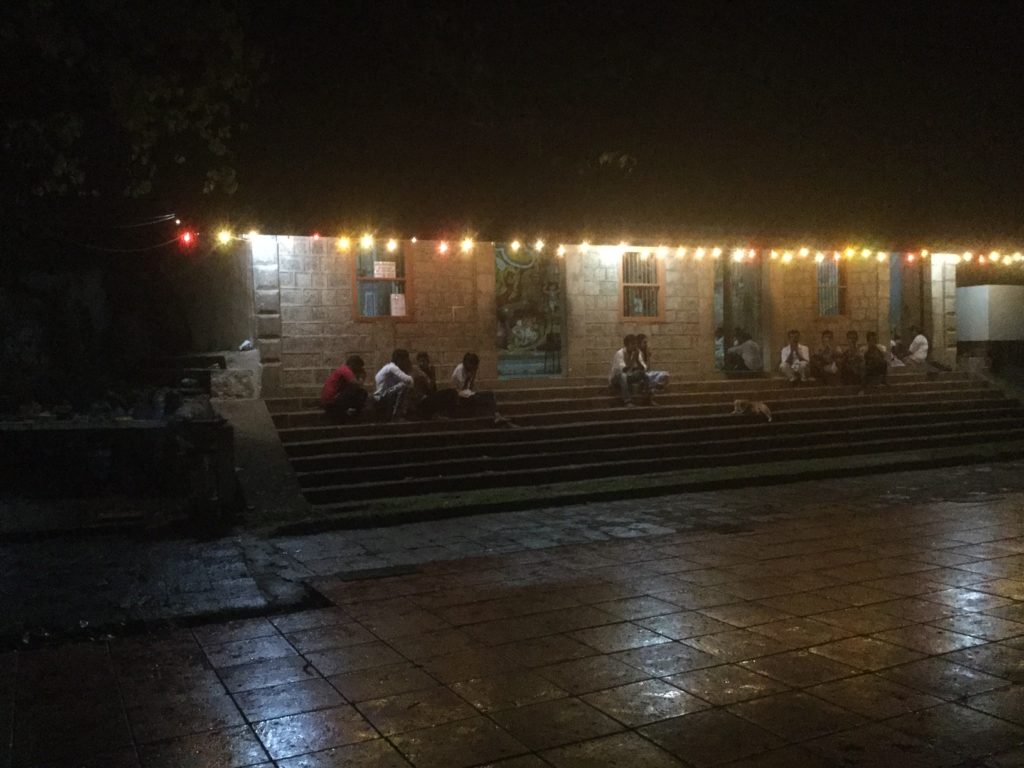
People casually sit on the steps outside the small temple. listening to the prayers.
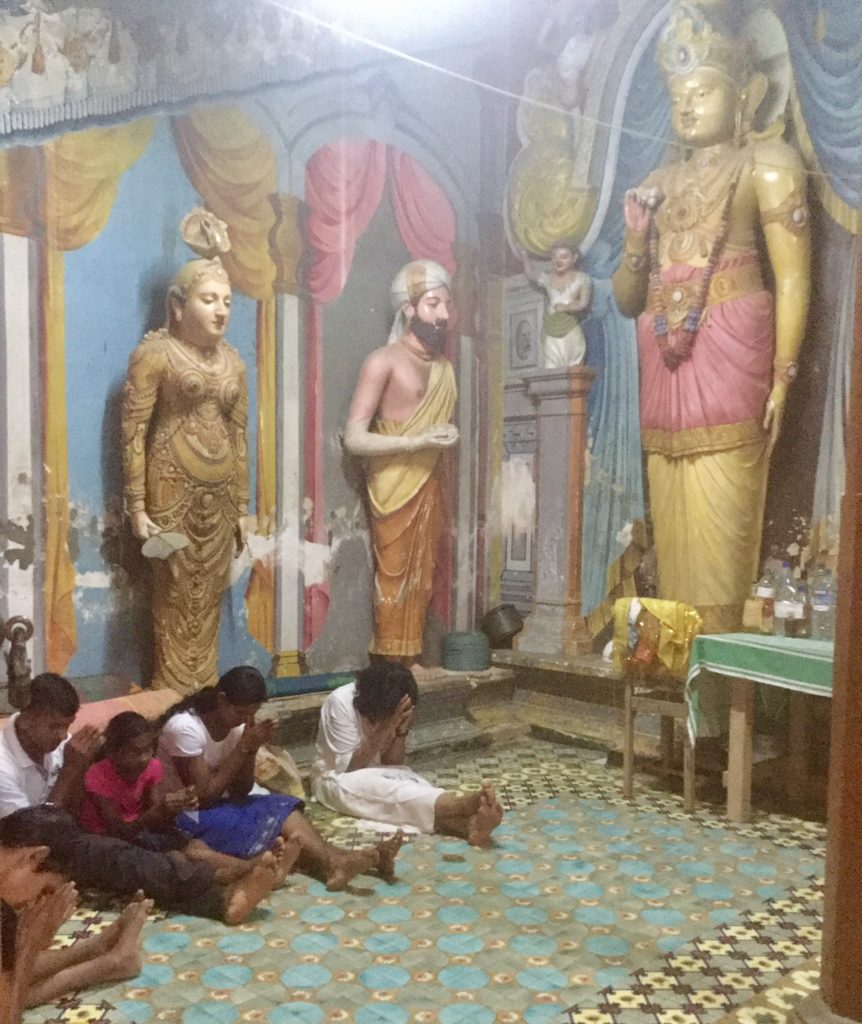
The inside of the temple where people sit on the floor in prayer.
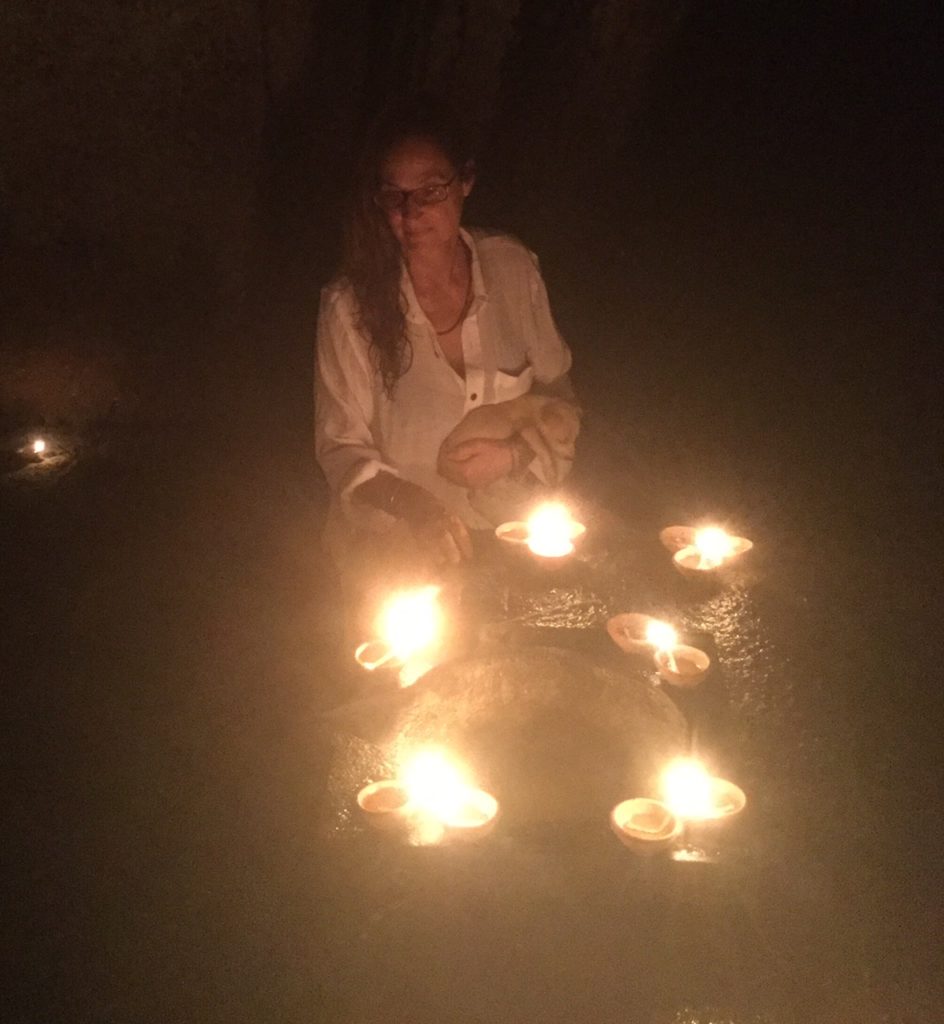
You might notice the little puppy in the nook of Peta’s left arm. Just outside the temple we saw him ~ clearly lost, wet and alone. Peta scoops him up after establishing there is no mommy dog, and he joins us to the Poya. It was inevitable that a dog or cat would make its way into our home soon enough.
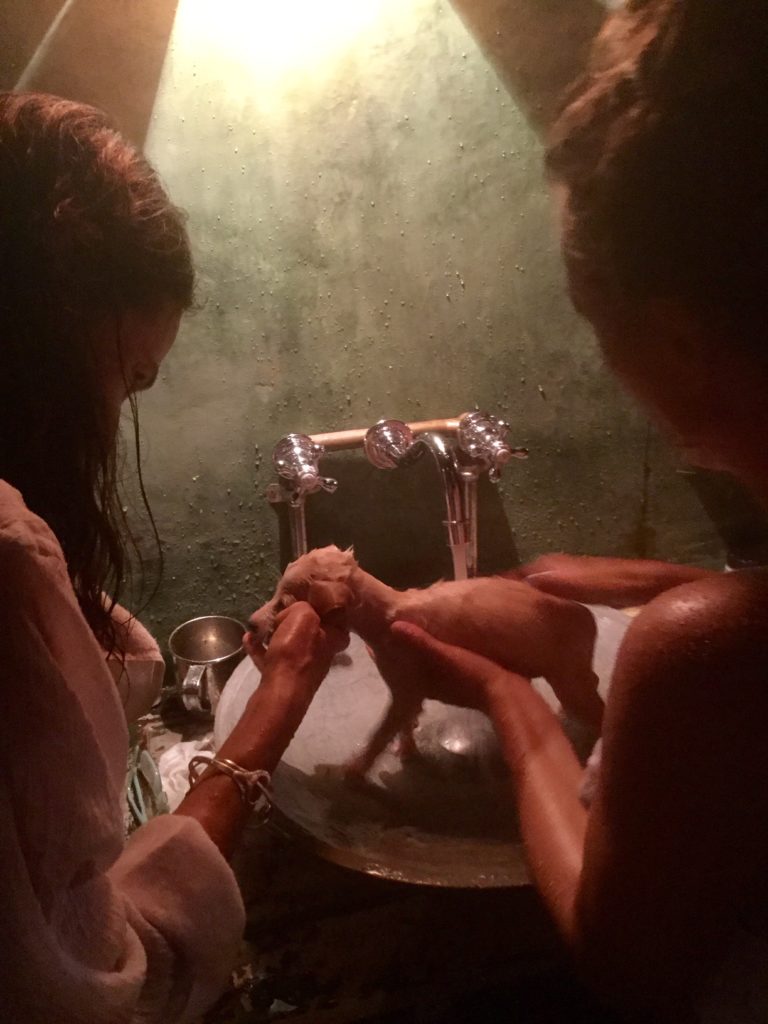
It takes three warm baths to get all the fleas off this little guy, aptly named “Poya”. Our first foster in Sri Lanka lives with us for about a week before we find him a loving permanent home.
Because it is night time, there is much we cannot see of the temple surroundings, which look beautiful. So we return a few days later in the daytime. It turns out that our neighborhood temple is one of the oldest temples on the island of Sri Lanka, probably from the same era as the magnificent cave temples from Dambulla Caves.
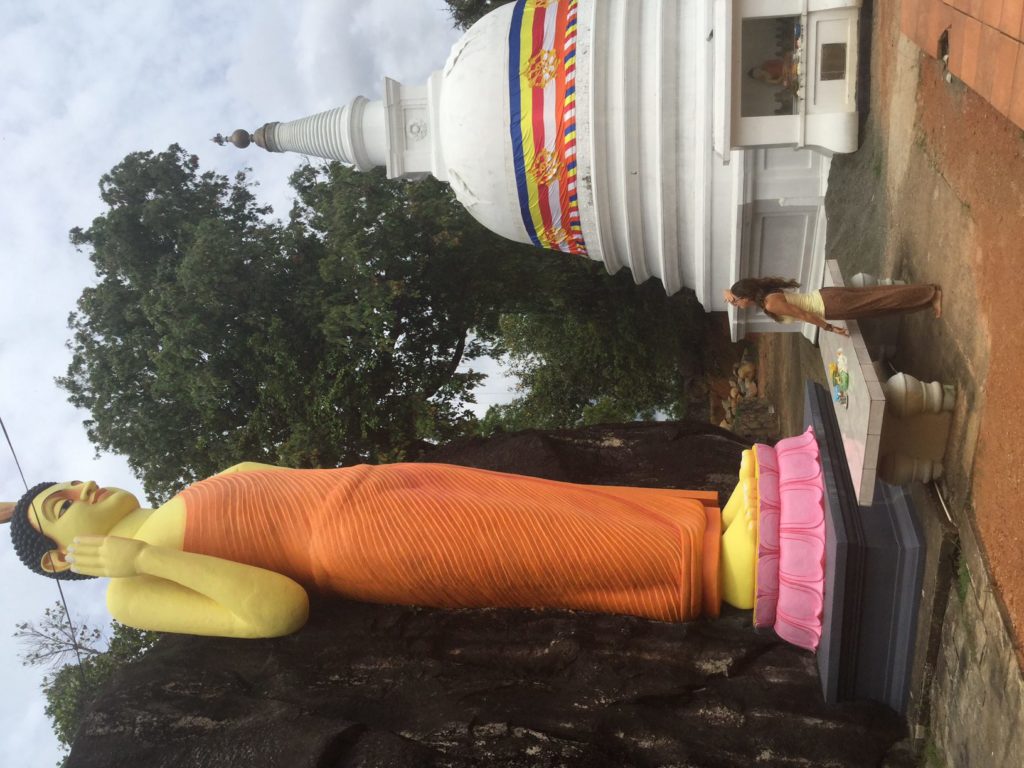
We are surprised in the daytime that the Buddha is in fact bright yellow and orange and is so much larger than we realized.
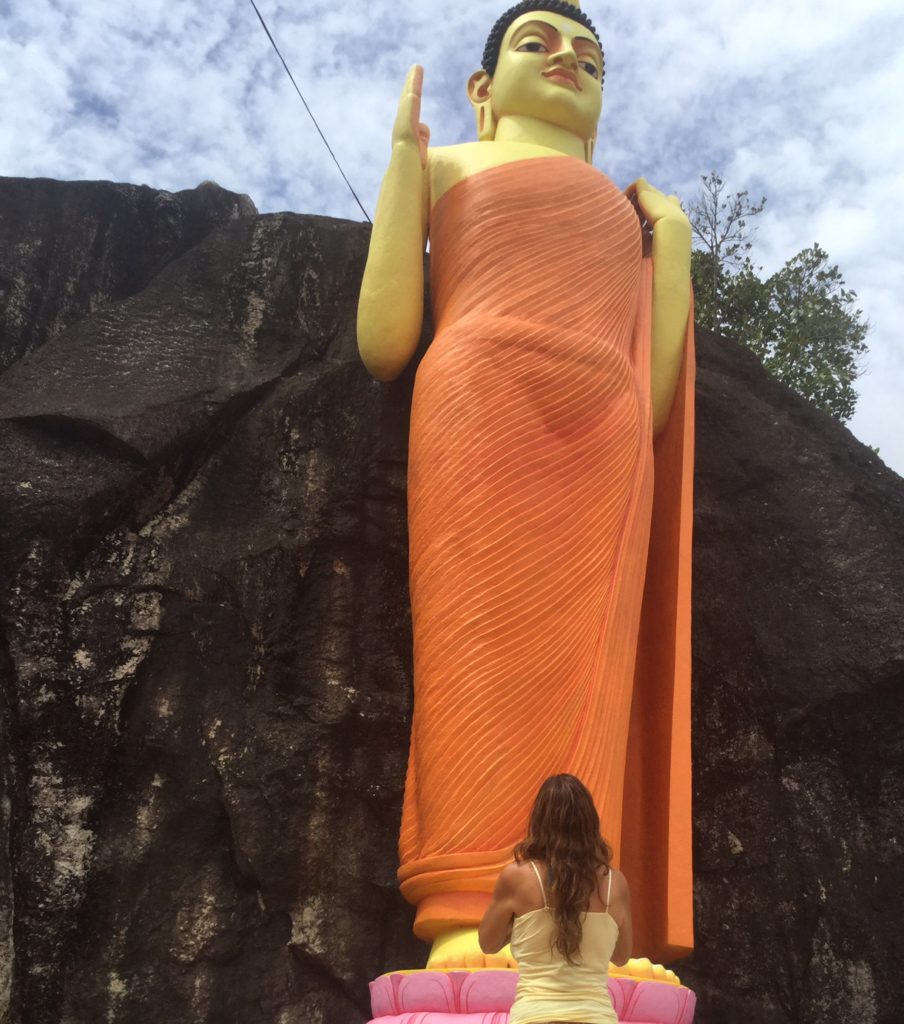
The interior of the temple has murals on the walls and ceilings.
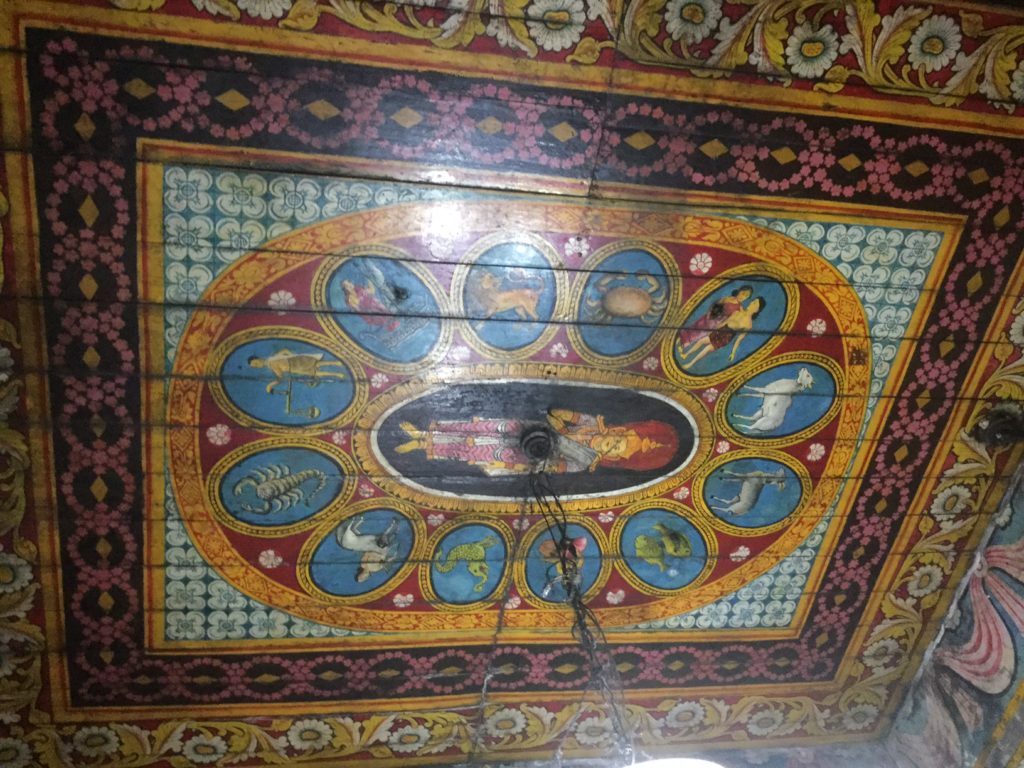
The painted ceiling of a temple room.
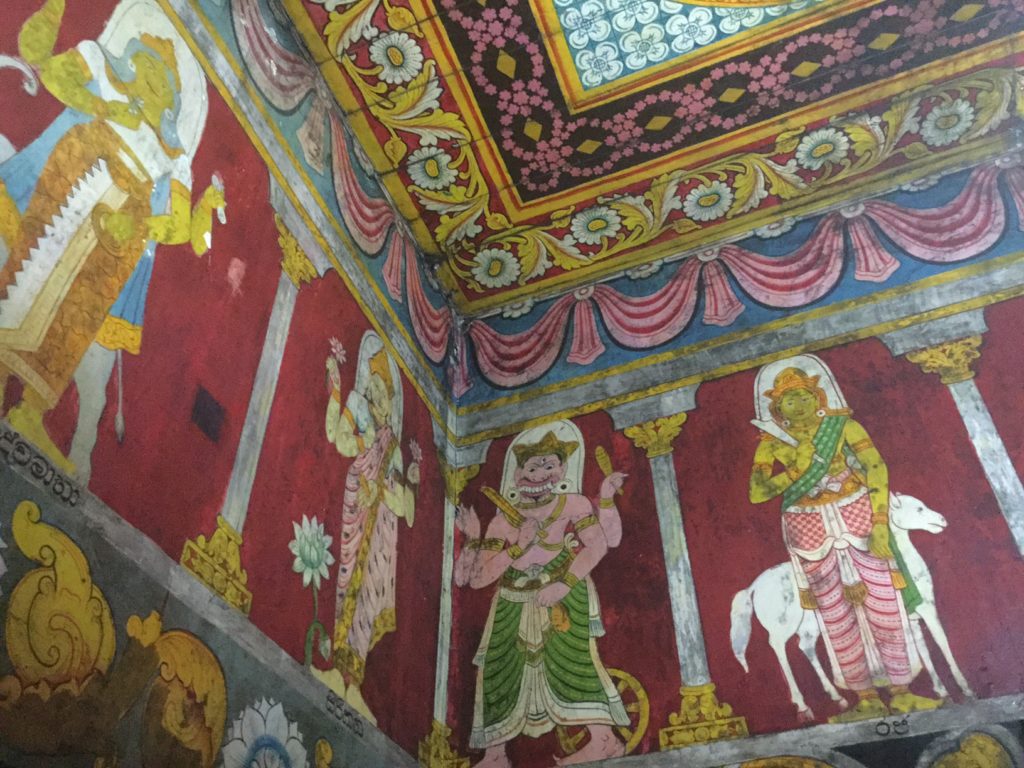
Murals of figures, against a bright red background make for a dramatic room.
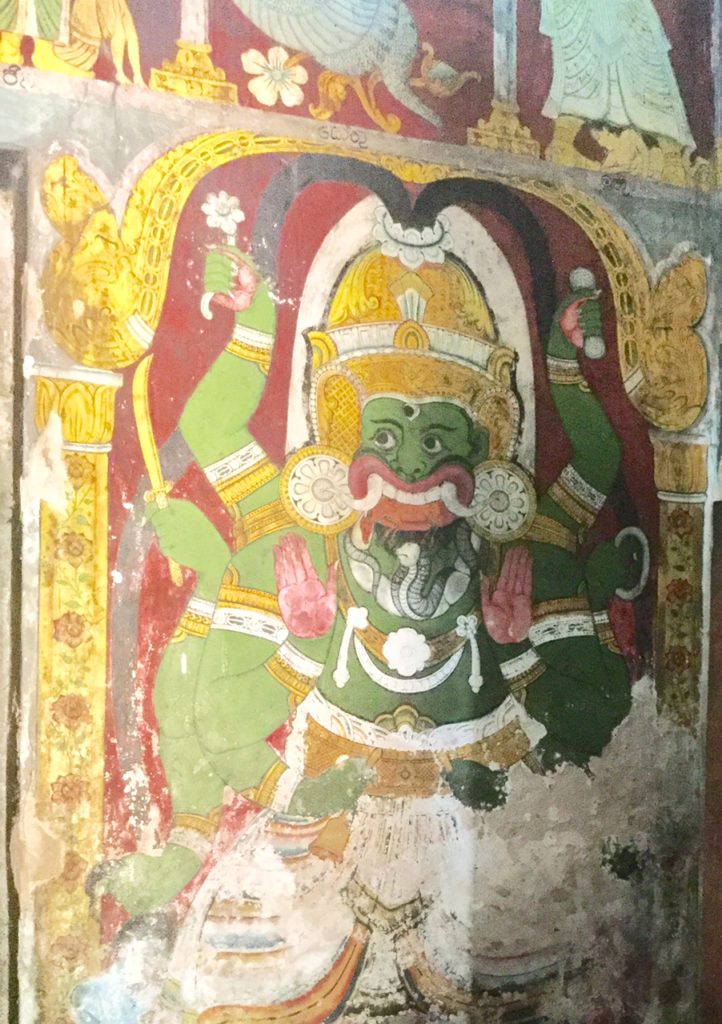
The green ogre?
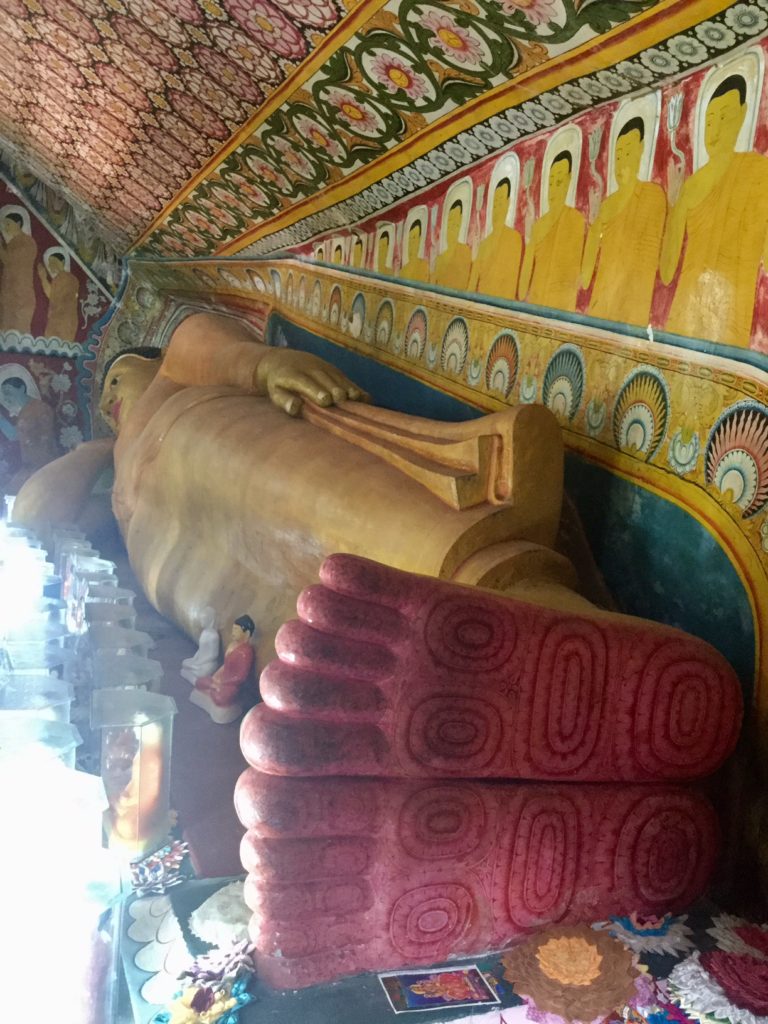
This sideways sculpture of a Buddha reclining has bright pink feet with red “finger prints.” On the wall behind is a row of monks in yellow robes.
One of the unique features of Sri Lankan temple art is a style we have never seen anywhere else, namely a concept of three dimensional paintings. Indeed 3D sculptures were built and positioned such that they seem to jump out of the two dimensional paintings on the wall
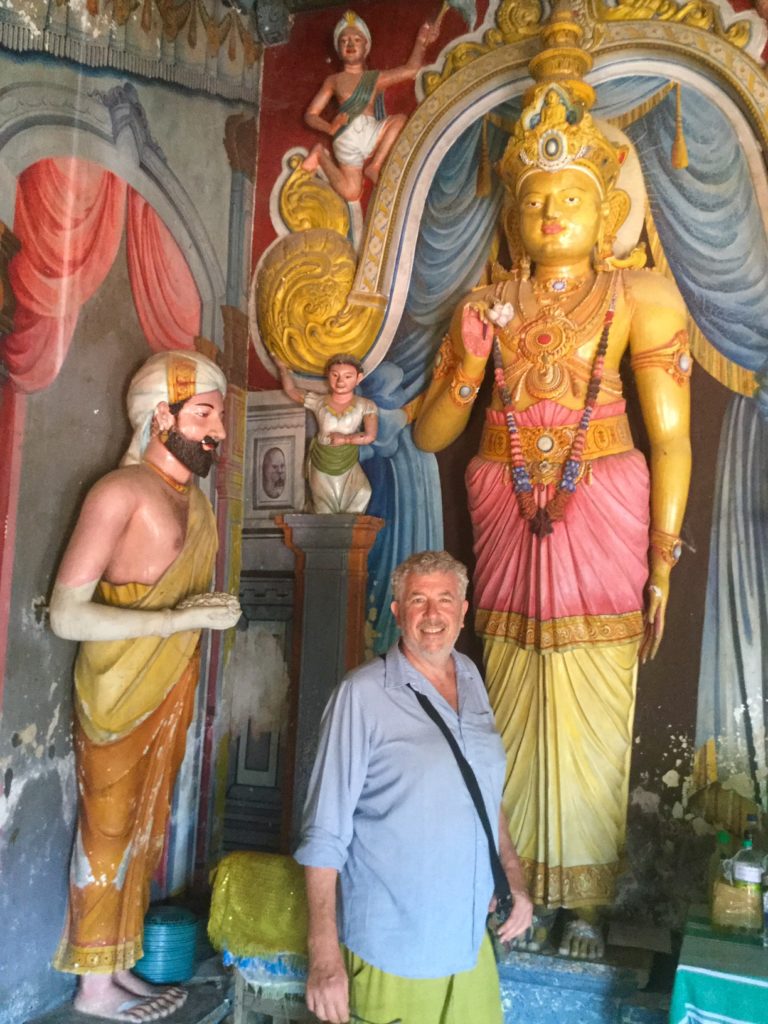
Ben seems to fit right in.
Stepping outside the temple there is a huge Banyan holy tree (the Buddha famously meditated under a Banyan tree for seven days after reaching enlightenment.) The holy tree points the way toward the most beautiful part of the grounds.
Huge boulders create a cave like space in which there is a stone carved Buddha.
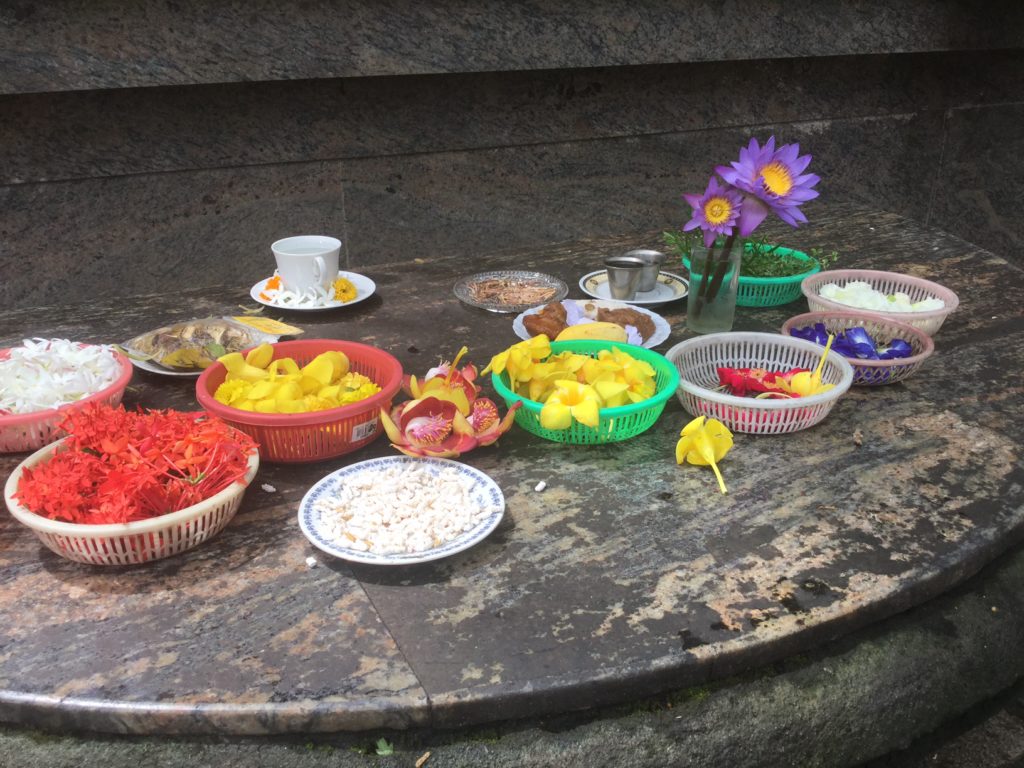
Offerings of flowers, rice and incense.
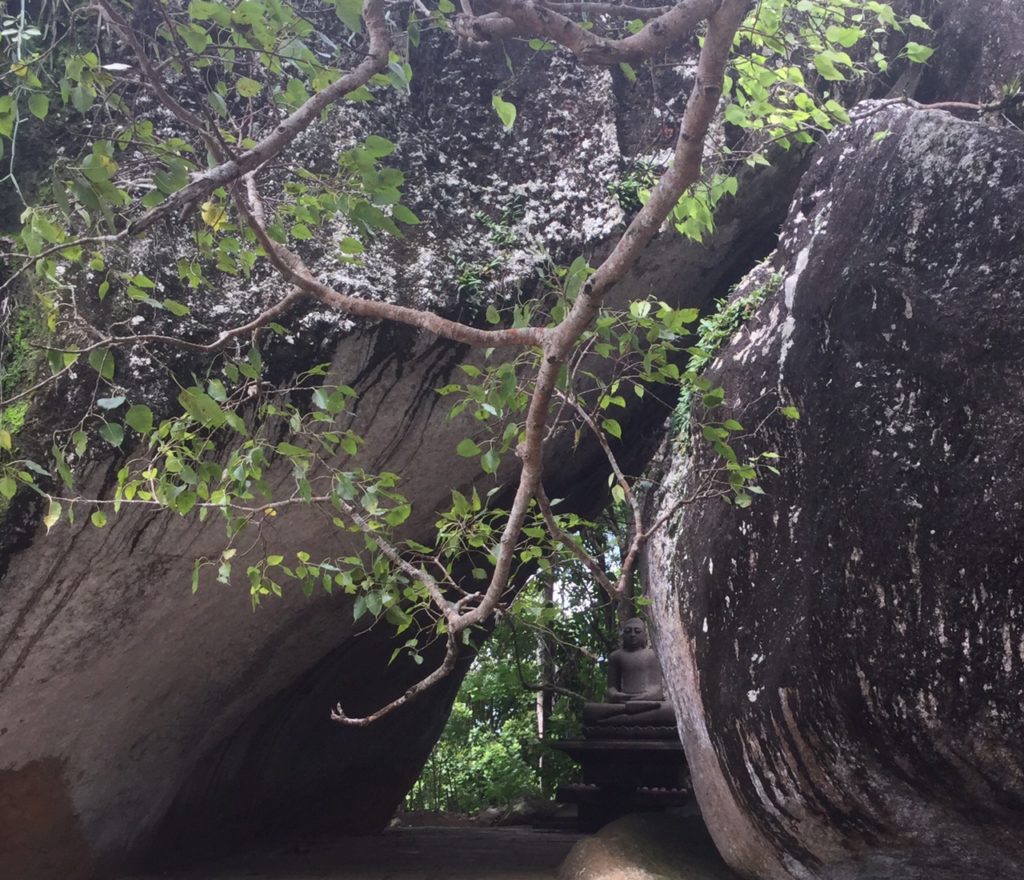
Behind these huge boulders, one can barely see the stone Buddha sculpture in the middle.
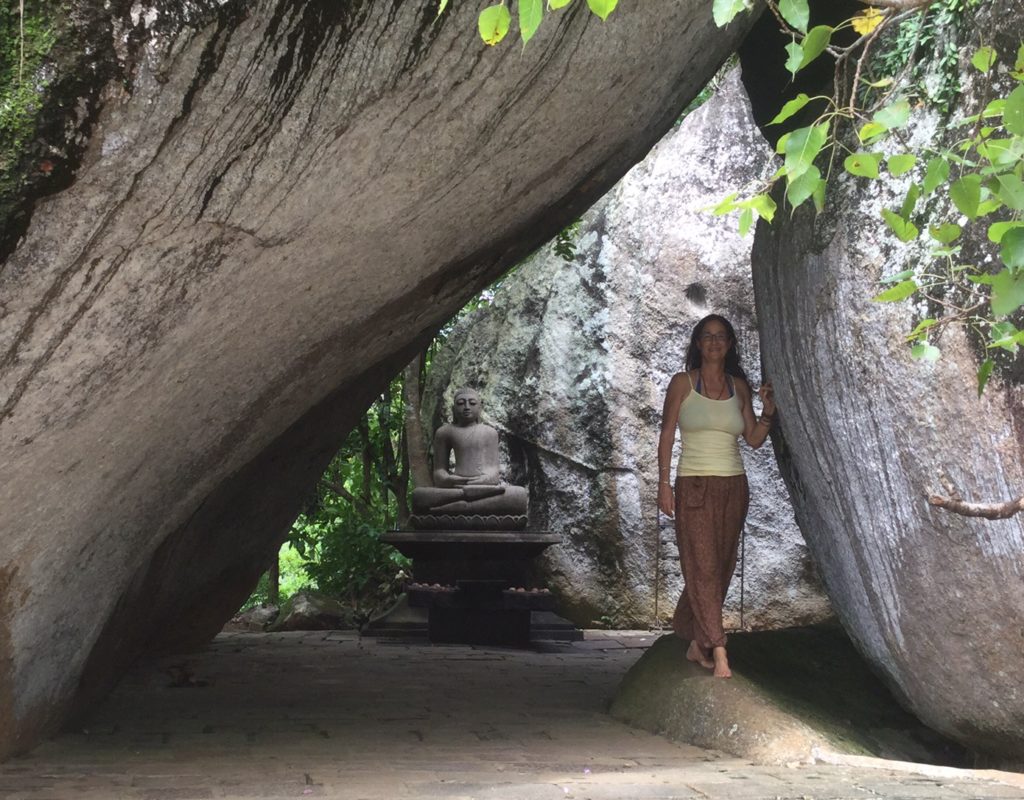
The huge boulders create a natural curved shaped pathway towards Buddha.
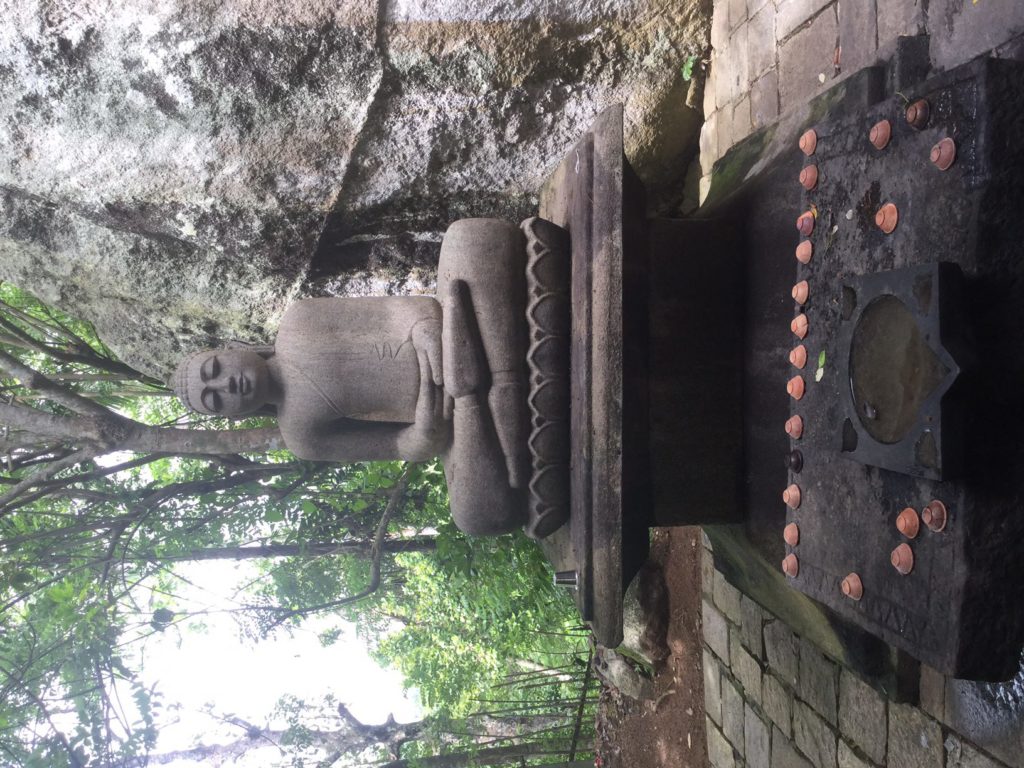
A modern looking graceful sculpture of Buddha in the foreground, with cave above and forest behind.
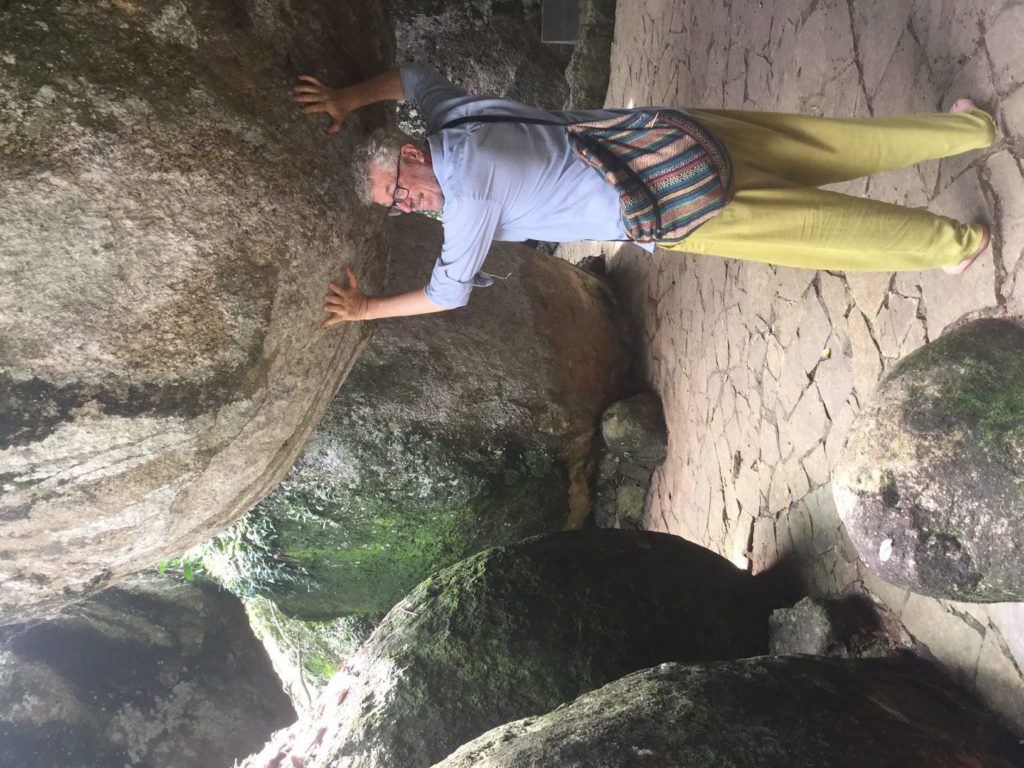
Ben in an Asian rendition of King Atlas.
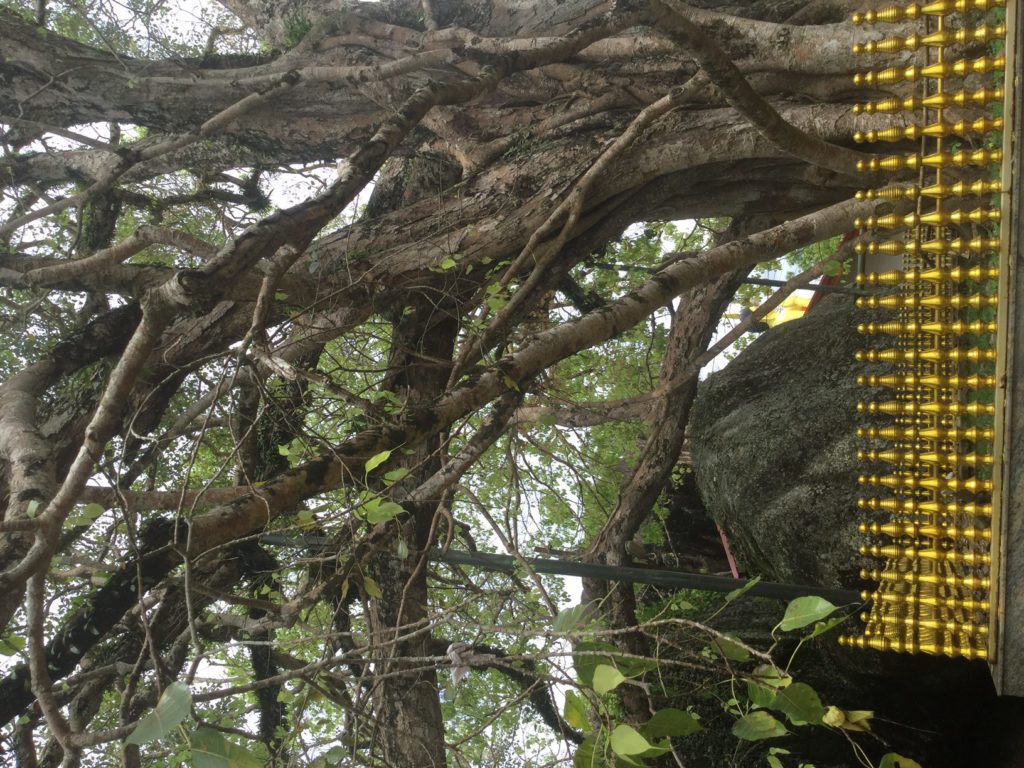
The Banyan tree, revered by all Buddhists. Beyond its historical and religious significance, the Banyan tree is full of health inducing properties.
A bit more history, for those so inclined…
As a distinct sect, Theravada Buddhism developed in Sri Lanka and spread to the rest of Southeast Asia. Theravada Buddhism is the religion of 70.1% of the population of Sri Lanka.[3] The island has been a center of Buddhist scholarship and learning since the introduction of Buddhism in the third century BCE producing eminent scholars
Monks from Sri Lanka have had an important role in spreading both Theravada and Mahayana throughout South-east Asia. It was in Sri Lanka, in the 1st century AD during the reign of King Vatta Gamini that the Buddhist monks assembled in Aloka-Vihara and wrote down the Tripitaka, the three basket of the Teachings, known as the Pali scriptures for the first time. It was Sri Lankan nuns who introduced the Sangha of nuns into China in 433AD. In the 16th century the Portuguese conquered Sri Lanka and savagely persecuted Buddhism as did the Dutch who followed them.
Throughout most of its history, Sinhalese kings have played a major role in the maintenance and revival of the Buddhist institutions of the island. During the 19th century, a modern Buddhist revival took place on the island which promoted Buddhist education and learning. There are around 6,000 Buddhist monasteries on Sri Lanka with approximately 15,000 monks.
The Yatagala Raja Maha Viharaya (our “neighborhood temple) is a quiet rock temple with a 9m reclining Buddha. The mural-covered walls are painted in the typical style of the Kandyan period.
Monks have been living there for at least 1500 years.
We were like you guys in Asia – we’d drop into just about every Buddhist temple we came to and meditate for a while. In Chiang Mai we meditated with the monks in one of the smaller, less-well-known temples and they invited us to come live with them in the monastery. We were tempted.
Your neighbourhood temple sounds wonderful. I can see the strong Hindu influence in the art work – similar to Bali.
Alison
Thanks Alison.
For me, the philosophy of Buddhism began in Nicaragua ~ through yoga and yoga teachings. Observing rather than judging is one of the underlying basics that I try to incorporate into my daily life. And the lessons of mindfulness from the meditation retreat in Chaing Mai have stayed with me as a constant.
We both look forward to more time at the temple near us, as it has such a lovely setting with the view from the stone buddha over the valley and the huge boulders. As well, no doubt we will discover many more temples as we continue to explore Sri Lanka.
Peta
Very interesting post, Ben! While I knew of the troubles in Myanmar and its government (when I was backpacking in SE Asia 16 years ago, I principally did not want to visit) I had no idea that Buddhists are (still) oppressing Muslims there.
It is so great that you are both embracing the religion and that it comes natural to immerse instead of just observe. While I do not believe in reincarnation, Buddhism is as close a religion as I will ever feel connected to. You make me want to go back to SE Asia, especially Bali and Thailand!
Thanks Liesbet for your thoughtful comments.
Just as a matter of clarification, Buddhism is not a religion in the traditional sense, it is closer to a set of philosophical beliefs.
“Buddhism doesn’t fit neatly into either category of religion or philosophy. When people asked Buddha what he was teaching, he said he teaches “the way things are.” He said nobody should believe his teachings out of faith, but instead they should examine for themselves to see if they are true or not.”
Webster’s Dictionary defines religion as: “any specific system of belief and worship, often involving a code of ethics and a philosophy.” Buddhism would not be considered a religion under this definition, because it is basically non-theistic ~ it does not generally involve worship of a supernatural entity.
Of course, as a set of beliefs and practices espoused by billions of people over the last 3,000 years, it is a richly complex set of observations and many people can focus on different aspects of that history. Most intriguing for me, is the aspect which correlates with Einsteins scientifuc observation that energy never disappears, it only changes form.
Ben
Thanks for the clarification, Ben. I “belief” in philosophies more than religions. 🙂
De nada Liesbet.
Thank you for the visual delights and getting me psyched to visit the amazing places that await me when I start traveling again. As a student, I studied the impact of religion on society (US and Japan) so your post brings me back to a favorite topic of study and massively expands upon my knowledge. I too am ‘Jewish but with a strong affinity towards Buddhism’ but likely wouldn’t have had the smarts that Peta did to simplify my explanation and land myself that lovely Buddha on credit.
Kudos to you for fostering Poya and finding him a good home.
Great picture of you and Peta in Bagan, Myanmar!
Thanks Lisa.
It’s interesting how US/Japan studies then, has given way to US/Chinese studies now as China is now the dominant relationship that the US has to navigate. Of course for people who have interest and pay attention to Asia, the emergence of China was obvious, well documented and inexorable.
Poya the puppy is very happy in his new home apparently, living with an Italian family with kids and three other dogs and three cats. I confess to being a tad jealous that Poya is possibly getting gnocchi for dinner!
Enjoy the upcoming travels.
Ben
Always so interesting to read about a part of the world I know nothing about. I can’t help but be captivated by all the bright colours.
I think perhaps I should be exploring the Buddhist practices in my own very Asian neighbourhood.
For sure if you have an Asian neighborhood within reach, no doubt there are many treasures to be had close to your doorstep. You might like to start with any one of the markets and try one of the ten first items that you know nothing about….
The rich and bold colors are typical of Sri Lankan temples and of Sri Lanka in general. The temples just like cathedrals in Europe, were the natural venue to foster artistic development and the line between religion, philosophy and art, blurs when we visit a temple.
Ben.
Interesting post Ben and Peta. It only takes one visit to any Buddhist temple to begin to realize what a complex faith it is. But your wide-ranging and thorough post really brings the complexities more in focus. It’s interesting for me to consider religions and their histories, specifically changes in beliefs that have been changed and added from the original message. Of course, Buddha would never approve of any violence and Jesus’ concept of Christian charity was a cornerstone of his message. And yet, we see that followers of all religions bend these rules to rationalize their own actions. Thanks for a good reminder of the original message of the Buddha. ~James
Thanks James. By the same token it is quite obvious to anybody that has conversed repeatedly with Muslims, that the overwhelming majority of Muslims hear and adhere to the core peaceful message of Islam. And yet, we are reminded every day, that as you say, man tends to corrupt the original message for his own political means.
Another dissonance between Buddhist theory and reality that we often encounter in Asia (and which we haven’t yet found a way to reconcile ourselves with), is the Asian practice of keeping birds in small cages (and even the practice of selling them in order for them to be released in order to obtain a pinch of good luck and good karma).
Ben & Peta
I feel like I just entered another country and came away with a better understanding of Buddhism. Though I studied it a bit in college, your detailed observations of the regional differences make more clear the depth and range of this practice. How interesting that Laos has a tradition of boys entering the monastery for a time. Wonder what the world would be like if that was the expectation for every culture. Thank you for the photos and the history.
It is a powerful thing when every single adult male in a country (Laos) has been a monk for a certain period of time. The more time that is spent being a monk the more the family is said to receive Buddhist merit. In the monastery education is revered, and therefore young boys who spend years there, get the best available education in philosophy but as well in mathematics, languages and the Sciences.
Luang Prabang, where we lived for about 5 weeks, has over 200 Buddhist temples! We particularly enjoyed the fact that we lived directly across the road from one of these temples and therefore could have repeated interactions with some of the young monks there. Some of our best memories of Laos were those enriching conversations… where we learnt about Buddhism and what a Buddhist monk’s life is like on a day to day basis. They too enjoyed practicing their English and hearing about our lives and families.
Peta
——–You are both SOOoooo interesting, evolving, learning, exploring, & Teaching!
I savor & cling to your beautiful Buddhist words. ( even though I’m a Christian!!)
And the PETS— Oh, My!
You’re saving furry animals, which makes me overflow w/ joy.
You are pure “Love.” You are living “LIFE!”
PS. have I asked what your children think about your adventures?
WOW. Amaaaaaaaaaaaazing.
PSS. How many pets do you have? Are there many homeless cats? Big cats like tigers?!
xxx from MN.
Kim, you are always so positive and bubbling over with enthusiasm…. thank you for your oh so kind and lovely comments.
I do find it easier to save an animal than to keep walking by ~ as afterwards the image of that animal that I passed and did not help, stays with me for a long time. I have a few times saved a kitten or puppy while traveling… Most cities and towns have at least one animal shelter and they can usually help. In this case, the dog center (started and 80% funded by a German woman) currently has 50 puppies needing homes, so I was on my own. I took the puppy with to a yoga class and the first person I asked whether was the one that adopted the puppy.
In answer to your question: Two of our sons have told me that we inspire them with our nomadic adventures. One of them said that he feels it is important we are living our lives in a way that makes us happy (exactly what I tell them!), and the fourth told me he would rather we lived there (Chicago).
At highest count (when we lived in Nicaragua) we had a total of 8 cats and 3 dogs. We fostered about 30 cats and kittens over a period of 6 years and fed hoards of stray dogs on the street who would come to our front door for food and a dose of affection and attention. Currently there are 3 ‘stray’ dogs that seem to have made this house we are in, their home. No cats as of yet.
xoxo
P
As always, I await your reply. thank you for answering so quickly.
You are one of my new heroes!
And an inspiration to your kids, readers, humanity, & all lonely, furry PETS)))!! x
Awwww…you are making me blush.:)
Fascinating and clear account. Great pictures too!
Thanks Anabel. Living in predominantly Buddhist countries has been and continues to be an interesting experience, for learning.
“Buddhist teachings can be understood and tested by anyone. Buddhism teaches that the solutions to our problems are within ourselves not outside. The Buddha asked all his followers not to take his word as true, but rather to test the teachings for themselves. ln this way, each person decides for themselves and takes responsibility for their own actions and understanding. This makes Buddhism less of a fixed package of beliefs which is to be accepted in its entirety, and more of a teaching which each person learns and uses in their own way.”
Peta
I am drawn to Buddhism for many reasons and know a fair amount about it, but your post was wonderfully helpful in getting a grip on all the varieties. I think the place I felt most connected to it was in Tibet, a place that practically hums with a Tibetan Buddhist vibe that is present in every aspect of life. In my own travels, I’ve also been attracted to temples and monks and nuns, and I love comparing the adherents and ways of life in all these places! Great read – thanks!
Thanks Lex.
I have always wanted to go to Tibet, but then again, the political situation there is just so devastating. When did you travel there?
I can definitely relate to most of the basic underlying precepts (compassion, wisdom,mindfulness, karma….)of Buddhism and have enjoyed observing and as well learning from different monks in different countries ~ each their own “interpretation” of what Buddhism means and how it impacts daily life.
Peta.
I was there in 2009 and 2011. The political situation was not great, but I stayed solely in the Buddhist quarter, not giving the Han Chinese a dime of my money or a second of my time there! The second time, they closed the country to tourists after we were in, which was eerie, but fascinating!
I learned so much from this post Ben. I too feel leanings towards Buddhist doctrine. I met a man while we lived in Mexico who is Buddhist and he taught me much. I have a meditation practice and feel that my philosophies towards life are in line with the Buddhist tenets. I dream of traveling to Asia someday and immersing myself in this peaceful lifestyle. Thanks for writing this post.
“I dream of traveling to Asia someday”…. LuAnn, dreaming is the first part of manifesting a reality. If you dream it, you can send your energies to manifest that dream. Come on down….
Before you book your tickets, bear in mind that Asia offers a complex palate of experiences and while calm and serenity is part and parcel of a stay in Laos, Hoi An… the big Asian cities make New York look calm and serene!
Ben
Very informative and well written. It’s so amazing how all religions eventually have divisions that emphasize different aspects of the original root theology and absorb things from other religions they encounter. The struggle to be non-violent is the core challenge for all of us, whatever our religion or lack of it.
Thanks Eileen.
“Non-violence is at the heart of Buddhist thinking and behavior. The first of the five precepts that all Buddhists should follow is avoid killing or harming any living thing.” Buddhism is essentially a peaceful tradition.”
Yes, agree the the struggle to be non violent is the “core challenge for all of us”.
Peta
I do find the various concepts of religion confusing, and don’t totally adhere to any of them. Goodness, love and kindness are all qualities that speak to me. The open handed gesture- pay me when you can- is always heart warming, and I think there’s a lot to be said for ‘monk school’. It’s an opportunity many of us have been deprived of. Thank you for a thoughtful and interesting post. 🙂 🙂
Thanks Jo. The problem that an increasing number of Westerners have with religion seem to center around the organised part of religion and the requirement of faith in an all powerfull unseen entity. It is seldom about the broad topics of benevolent behaviour (compassion, love etc). In this respect Buddhism can become attractive precisely because it is neither requiring blind faith nor functions through a centralised organization. All it basically requires is for one to experiment with the core concept of mindfulness. Minfulness when speaking, when eating, when doing anything.
Peta & Ben
Thank you for this fascinating account of Buddhism and its different forms. I must admit my ignorance here as I didn’t know it had so many different branches and manifestations. Your local temple is beautiful but I had to take a second look at the architecture and decorative elements. It reminds me of some of the Hindu temples we visited in Singapore’s Little India (especially the green ogre).
Great story about the wooden Buddha statue you got at the market…it’s a beauty.
Thanks Caroline.
You are correct in that observation re Hindu temples ~ “Hinduism predates Buddhism by two millennia and is the substrate from which Buddhism emerged. Buddha himself was born a Hindu, and the religion he founded was, in many ways, a revolutionary movement within Hinduism. Consequently, despite their differences, the two have many concepts in common. Some of them are as ancient as the Vedas, even though Buddhists don’t place any importance in these seminal scriptures at the heart of Hinduism.”
Just yesterday we were in a very ornate Hindu temple in Colombo, much like the one in Singapore. About 9% of the Sri Lankan population are Hindu.
The carved wooden Buddha has the living room entirely to himself.
Peta
When i read your posts I feel as if I am following you around this beautiful world, learning as I go. Not that I absorb everything to be sure. But the sense of goodness and kindness that you both find and model for all is something I am most grateful for.
Thanks Sue that really means a lot to me.
Namaste, Peta
Such lovely photos and the statues and architecture are amazingly vibrant and colorful. while I’m not a very spiritual person, I am drawn to the tranquility of the temples and learning more about these ancient religions. There is a soothing calm and happiness in life’s simple pleasures in many of the places you have pictured. Anita
Thanks Anita for the lovely compliments.
I always find that being in a Buddhist temple helps me be in the calmness of the present moment. The same feeling I get when I am in nature. This particular ancient temple has such a beautiful location ~ with the combination of the huge boulders and the setting amongst the rice paddies and jungle. I look forward to returning there many times.
Peta
Excellent post. I was having a discussion on Buddhism with my son not too long ago on this topic as I was under the misguided impression that Buddhism was a religion and he said it was more a way of life. I had no idea there were so many sects and I find it all so fascinating.
Thanks Steph!
The two major schools of Buddhism, “Theravada” and the “Mahayana”, are to be understood as different expressions of the same teaching of the historical Buddha. Because, in fact, they agree upon and practice the core teachings of the Buddha’s Dharma. (Mahayana Buddhism is found primarily in Tibet, Nepal, China, Korea and Japan.)
Peta
A wonderful informative post. I’ve travelled a reasonable amount in Asia but you have made clear some of the differences between the different Buddhist sects. Wouldn’t it be a wonderful world if all children entered a monastery/nunnery and learnt peace and respect rather than national service where they learn how to operate weapons of war.
Irene thanks for stopping by our blog and commenting.
Yes, if that were the case, we would certainly have a population with a different mindset and different priorities. It baffles the mind when looking at the budgets of so many countries (not only the U.S) to see how much money is spent on defense versus other national priorities such as education, health care etc.
Re Buddhism, it is not so much that there are different sects as there are applications of Theravada Buddhism in a variety of cultural contexts where the populations have their distinct histories, languages and overall environments. All the countries we have been to and commented on share a common lineage of Theravada Buddhism (except Viet Nam and Cambodia.)
We are looking forward to traveling extensively in countries where Mahayana is predominant. Mahayana Buddhism developed out of Theravada tradition roughly 500 years after the Buddha attained enlightenment. (Mahayana Buddhism spread from China to Tibet, Korea, Japan, Viet Nam and Cambodia.) We dipped our toes in Mahayana Buddhism while living in Viet Nam and visiting Cambodia and look forward to visiting Tibet and Nepal at some point.
Interestingly, the emphasis on the practice of yoga and mediation as the most effective method for the attainment of the highest truth (Bodhi) is associated with whats called the Yogacara school which is a branch of Mahayana Buddhism. IN short, by virtue of our practicing yoga we are in fact a tad closer to Mahayana Buddhism. As you can tell, we still have much to learn.
Ben
Such an interesting post, thanks a lot Peta for pointing it to me. I have been lucky enough to have traveled to lots of those places, so it was also a nice walk down memory lane 🙂
The nuances are pretty interesting in practice. In Thailand for instance, we had a hard time implementing our humanitarian programs because we were seen as disturbing the course of life: If a man is in prison, he should stay there because of the bad he did in his previous life, and we should not intervene. Giving an helping hand was not considered as in our occidental culture, something you re doing out of empathy and generosity. There you are helping because it is good for Your kharma. It took me quite lots of time to adjust, to understand their practice. But this is what I love about traveling, feeling challenged in my assumptions and having to press on pause to understand ..
You made me laugh with your line on “Jewish but with a strong affinity towards Buddhism”. In the Philippines most of taxi drivers will ask about your religion. At the beginning I used to say Jewish, but the answers I got were “But this is Christian, right?”. Buddhist was easier to understand, so I sticked to it (here). Plus as my grand mother would say, “how can you know for sure this Buddha was not Jewish?” 😉
Thanks again for another great post, you are very inspiring! So happy to have the chance to follow your adventures ..
Btw the retreat you did in Northern Thailand was a silent one?
Thank you Estelea, for the additional layer of cross cultural communication in the anecdote re Thailand. Fascinating. Thanks for a great example of a Buddhist spin on a Western NGO’s well intended initiative. Love how unpredictable the opportunities for learning are when living in a foreign land. We like that phrase “press on pause” to understand. All to often travel is hurried and therefore there is but a recording of experiences with no time to pause an digest information, let alone interpret. One of the reasons we prefer the sequential living, nomadic more is it allows us time to pause, reflect and hopefully learn beneath the surface. Much like you are doing in the Philippines.
I love your grandmother’s quote about the Buddha!! Classic (insert Yiddish accent preferably….)
Thanks for reading and commenting. The retreat we did in Chiang Mai was primarily meditation but speaking was encouraged during the occasional discussion sessions. They were not very strict in enforcing the silent part and during meals I actually would have preferred if they did as the background chatter was jarring after hours of meditation.
Peta
Thanks for the fascinating commentary and photos of your lovely selves. 🙂
Hey Yvette, thanks for stopping by our blog and leaving a lovely comment.
Peta
Thank you Yvette for stopping by to read us and to comment.
Peta
I first discovered Buddhist teachings in my early 20’s, and clearly remember thinking that I had found my spiritual “home.” Such simple and profound teachings—the precepts of cultivating mindfulness and compassion resonate most deeply with me and provide me with a lifetime of practice—especially mindfulness. 🙂 Your photos of the temple art are beautiful! And I love the story of the puppy and Peta.
I agree Laurel that mindfulness when practiced is a lifelong gift. When we attended the meditation retreat in Chiang Mai we learnt mindfulness in walking, step by step by step, mindfulness in eating. Holding onto it all in every day life is the challenge, but definitely rewarding. Makes me realize how after 2 years in Asia we have incorporated so much of Buddhism in our daily lives. And coupled with yoga philosophy we are fairly well entrenched…. But always more to learn…
The little puppy is doing very well in his new home along with three other adult dogs and a little Italian girl that is crazy about him. He is definitely one of the lucky ones. You might enjoy this story of a prior dog rescue when we were in Dominican Republic for a day…
http://www.greenglobaltrek.com/2010/11/dominican-republic-first-stop.html
Peta